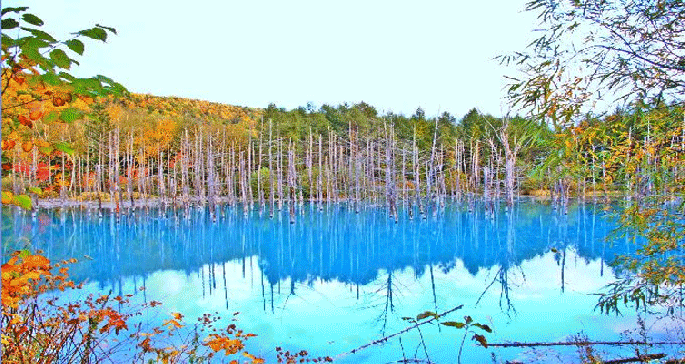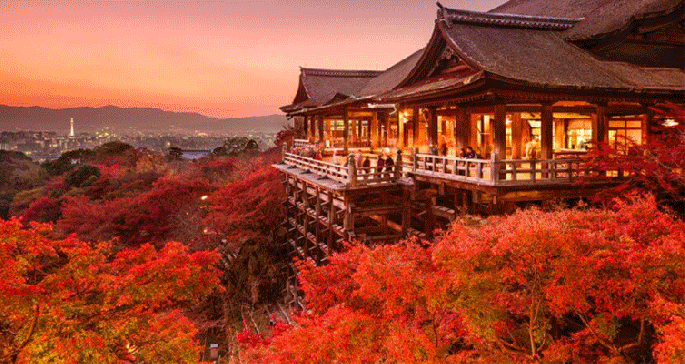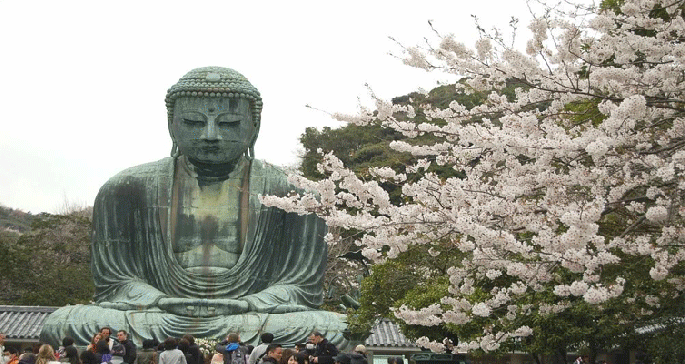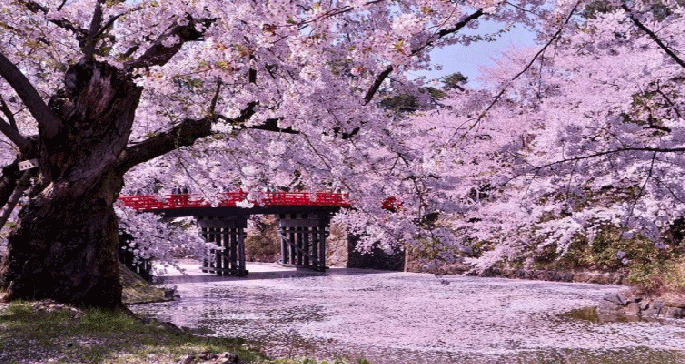Here are the top ten tourist attractions in Japan while visiting this beautiful country.
10. Hitachi Seaside Park in Ibaraki

A wide variety of seasonal flower gardens. Refreshing breeze blowing through the flowers and greenery filled city park. Hitachi Seaside Park is located on the Pacific Ocean side of the Japanese coast, and incorporates a unique natural environment of sand dunes, forests, grasslands and springs.
Hitachi Seaside Park also features a small amusement park with over 25 rides and attractions, including a 100 meter tall Ferris wheel, putter golf, a BMX course and a roller coaster among others. Most of the rides and activities require extra fees. Restaurants and rest areas are scattered throughout the park, and a BBQ area is available for picnics.
9. Blue Pond in Hokkaido

The Blue Pond in Biei, Hokkaido has become a hot tourist spot in recent years. The pond displays various hues of blue depending on the season and the weather. Even a slight breeze will change the pond’s appearance. When there is no wind at all, the pond looks as if it were an enormous mirror laid out on the ground. The Blue Pond is only one part of a harmonious symphony. The other part is its surrounding forest. The water’s enigmatic color has also made the pond a popular spiritual place.
8. Jigokudani Monkey Park in Yamanouchi, Shimotakai District, Nagano Prefecture,

The Jigokudani Monkey Park offers visitors the unique experience of seeing wild monkeys bathing in a natural hot spring. The park is inhabited by Japanese Macaques, which are also known as Snow Monkeys. It is located in the monkey’s natural habitat, in the forests of the Jigokudani valley in Yamanouchi, not far from the onsen towns of Shibu and Yudanaka. The park has one man-made pool around which the monkeys gather, located a few minutes’ walk from the park entrance. Visitors will likely already encounter monkeys along the path to the pool. The monkeys live in large social groups, and it can be quite entertaining to watch their interactions. Accustomed to humans, the monkeys can be observed from very close and almost completely ignore their human guests. Naturally, it is prohibited to touch or feed the monkeys.
7. Himeji Castle

Himeji Castle, also known as White Heron Castle (Shirasagijo) due to its elegant, white appearance, is widely considered as Japan’s most spectacular castle for its imposing size and beauty and its well preserved, complex castle grounds. The castle is both a national treasure and a world heritage site. Unlike many other Japanese castles, it was never destroyed by war, earthquake or fire and survives to this day as one of the country’s twelve original castles. The castle recently underwent extensive renovation over several years and was fully re-opened to the public in March 2015.
6. Kenrokuen Garden

One of Japan’s Three Most Beautiful Gardens
Kenrokuen Garden is a beautiful Japanese garden with an area of 11.4 hectares located on the heights of the central part of Kanazawa and next to Kanazawa Castle. The Maeda family, who ruled the Kaga Clan (the present Ishikawa and Toyama areas) in feudal times, maintained the garden from generation to generation. From its scale and beauty, it is regarded as one of the most beautiful feudal lords’ gardens in Japan.
Kenrokuen Garden has a big artificial pond, and hills and houses are dotted in the garden. Visitors can appreciate the whole, dropping in at them. The big pond called “Kasumigaike” was compared to an open sea, and an island, on which an ageless hermit with miraculous power was believed to live, was constructed in the pond in hope of the long life and eternal prosperity of the lord. Kenrokuen, which means “having six factors”, was given the name because of the six attributes that bring out the perfect landscape of the garden: spaciousness, tranquility, artifice, antiquity, water sources, and magnificent view from the garden.
5. Kiyomizu-dera Temple

Kiyomiuz-dera Temple is just about everything a temple shouldn’t be: it’s noisy, crowded, crassly commercial (in its sales of amulets and fortunes), and as gaudy as an attention-starved peacock, but it somehow manages to transcend all of this to become one of Kyoto’s most worthwhile temples to visit. Start by climbing Chawan-zaka or Kiyomizu-michi to get there and you’ll soon see the brightly painted entrance gate and pagoda. Before buying your ticket to enter the main compound, ask someone to point you in the direction of the “Tainai Meguri.”
4. Great Buddha of Kamakura

The Great Buddha of Kamakura is a bronze statue of Amida Buddha, which stands on the grounds of Kotokuin Temple. With a height of 11.4 meters, it is the second tallest bronze Buddha statue in Japan, surpassed only by the statue in Nara’s Todaiji Temple.
The statue was cast in 1252 and originally located inside a large temple hall. However, the temple buildings were destroyed multiple times by typhoons and a tidal wave in the 14th and 15th centuries. So, since 1495, the Buddha has been standing in the open air.
3. Ishigaki




